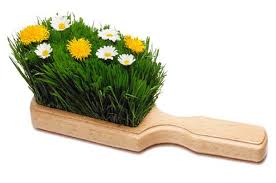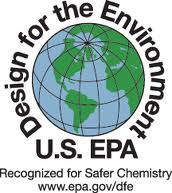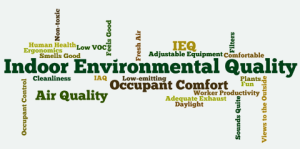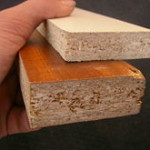They Go Hand-in-Hand

First, some late breaking news– 101 houses of worship, including the Formation Building, have been registered for LEED certification. To date, 31 have been certified. 17,150 commercial or institutional projects are LEED certified in the U.S. alone. Worldwide, see this info graphic. There have been 45,326 housing units certified in the U.S. under the LEED for Homes rating system.
GREEN CLEANING/HOUSEKEEPING and IEQ
One of the LEED Innovation and Design Process (ID) credits often recommended by green building consultants to owners for both new construction/major renovation project and existing buildings is Green Cleaning/Housekeeping. When committing to Green Cleaning/Housekeeping, there are positive implications for IEQ (Indoor Environmental Quality), a major LEED rating category, outlined further below.
 Green Housekeeping– The U.S. Green Building Council and the The International Living Building Institute, along with the U.S. EPA, are among prominent green building rating organizations very committed to identifying and routing out dangerous or questionable chemicals commonly used in building construction materials and mechanical equipment, and commercial and household cleaners. Coming immediately to mind are: Freon (CFC), a refrigerant used in auto and building air conditioning units; Formaldehyde, used in plywood/fiberboard; and, bleach (sodium hypochlorite), used in many cleaners/whiteners. Of these three, Freon has been severely restricted or banned by the Montreal Protocol, and Formaldehyde in building products has largely been replaced by environmentally friendly alternatives.
Green Housekeeping– The U.S. Green Building Council and the The International Living Building Institute, along with the U.S. EPA, are among prominent green building rating organizations very committed to identifying and routing out dangerous or questionable chemicals commonly used in building construction materials and mechanical equipment, and commercial and household cleaners. Coming immediately to mind are: Freon (CFC), a refrigerant used in auto and building air conditioning units; Formaldehyde, used in plywood/fiberboard; and, bleach (sodium hypochlorite), used in many cleaners/whiteners. Of these three, Freon has been severely restricted or banned by the Montreal Protocol, and Formaldehyde in building products has largely been replaced by environmentally friendly alternatives.
Bleach remains. But, there are good alternatives, including lemon, baking soda, vinegar and Borax. (In case you missed it, in a recent post called “Compost Cab” I embedded a video on how to mix up your own very green cleaning brews.)
 There are two lists of “chemicals of concern” identified by the U.S. EPA which you can check for in the labels of products used around your home. Called Safer Chemicals Healthy Families, click here to review the list, including suggested consumer product type uses. About a year ago, UL offered a study highlighting major differences in perception between the household cleaner industry and consumers: “UL Study Finds Consumer Distrust of Cleaning Supplies Despite Jan/San Industry Efforts.” Interesting!
There are two lists of “chemicals of concern” identified by the U.S. EPA which you can check for in the labels of products used around your home. Called Safer Chemicals Healthy Families, click here to review the list, including suggested consumer product type uses. About a year ago, UL offered a study highlighting major differences in perception between the household cleaner industry and consumers: “UL Study Finds Consumer Distrust of Cleaning Supplies Despite Jan/San Industry Efforts.” Interesting!
For the Formation Building, a Green Cleaning/Housekeeping program has been drafted for socializing with the Day School director, its cleaning company and our Sexton. But first, I’m reviewing it with one of the Environmental Missions Committee members, particularly for purging products used at SMC which contain harmful chemical ingredients listed thererin. (Update: the Green Housekeeping Plan has been awarded 1 LEED credit.)
The program is organized as follows:
SECTION A – SUSTAINABILITY MISSION STATEMENT
SECTION B – STATEMENT OF PURPOSE
SECTION C – CLEANING PRACTICE REQUIREMENTS
SECTION D – CLEANING SOLUTION SPECIFICATIONS
SECTION E – APPROVED PRODUCTS
SECTION F – STAFF TRAINING
SECTION G – RESOURCES
SECTION H – DEFINITIONS
SECTION I – CLEANING CHECKLIST
SECTION J – GREEN CLEANING CONTRACTOR DECLARATION
 IEQ– Within this LEED category there are two prerequisites, and a number of credits that can be earned.
IEQ– Within this LEED category there are two prerequisites, and a number of credits that can be earned.
The prerequisites (meaning you can’t get a LEED certification without adopting them) are two: Minimum Indoor Air Quality Performance (IEQ p1), and Environmental Tobacco Smoke Control (IEQ p2).
For IEQ p1, sections of ASHRAE Standard 62.1-2007 must be applied for mechanically ventilated spaces such as there’ll be in the Formation Building. IEQ p2 allows for a choice: no smoking in the building or close to any fresh air intake, door or operable window; or, an option where a designated smoking space may be constructed with direct exhausting to the outdoors and negative pressure differential with the surrounding spaces. As Maryland prohibits smoking in virtually all buildings, IEQ p2 is easy. There will, however, be No Smoking signs discretely and permanently posted at places along the exterior of the new building as per LEED specification.
Perusing through the credits, there are two involving an indoor construction management plan. Both during construction and pre-occupancy, the GC will have to follow certain green building protocols. One is to prevent open mechanical duct work during construction from being infiltrated by particulate matter, for example. Rated filters are installed temporarily at any open duct. And, after all interior finishes have been installed but prior to occupancy, either a whole building flush-out will be conducted or a testing of the air for contaminants like formaldehyde and carbon monoxide will be executed. Our GC assures the A&E Committee and your green building consultant that both of these credits will be obtained and documented by them.

Following on the benefits of these extra construction-period efforts towards a healthy indoor environment will be the use of building products made from what LEED refers to as Low-Emitting Materials. Commonly they’re called low-VOCs (volatile organic compounds). There are four types, all of which we plan to obtain for a LEED point each: Adhesives and Sealants; Paints and Coatings; Flooring Systems; and, Composite Wood and Agrifiber Products (particle/chip board, furniture).
The final IEQ credit to mention in this post is Indoor Chemical and Pollutant Control which we also plan to attain for 1 point. In a nutshell, it has to do with controlling the entry of pollutants into the building by use of minimum 10-foot-long roll-out mats to be thoroughly cleaned weekly, and direct exhausting of potentially hazardous gasses from the custodian room. (Update: the project has been awarded 1 LEED point for this design credit.)
HAPPY THANKSGIVING to one and all! (And, thanks for reading the blog.)